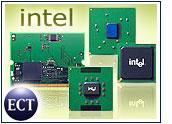
Intel marked the fifth anniversary of its Centrino line Tuesday with the launch of Centrino 2 platform for notebook PCs. The chipmaker will offer the platform with a range of five new Intel Core 2 Duo processors and later this quarter, the company will release a quad-core version of the platform.
The processor, chipset and wireless combo offers users up to 50 percent faster performance when multitasking, greater range and better wireless performance, as well as increased battery life that will allow consumers to watch an entire Blu-ray movie without using up the battery.
“It is an incremental advancement [over the previous generation of Centrino chips]. It is evolutionary, not revolutionary. The key thing is they are trying to stretch the battery life [of notebook computers]. It’s a great thing for the industry and they are making a sizable improvement on the battery life side,” said Ian Lao, an analyst at In-Stat.
Using Less Juice
The Centrino 2 platform includes 45-nanometer Core 2 Duo Processors that run at 2.26 GHz with the P8400, up to 3.06 GHz with the Intel Core 2 Extreme Processor, X9100. All the processors come with a 1066 MHz front side bus and up to 6 MB of L2 cache.
The X9100, T9600 and T9400 consume 44 watts, 35 watts and 35 watts of power, respectively. However, it is with the “P” chips in the series that Intel has made gains in lowering power consumption. The P9500, P8600 and P8400 each use only 25 watts.
“That affects things like the kind of power supply companies have to put in. It also affects the charge time because the bigger the battery you have to put in, the longer it takes to charge. All that affects the user experience overall. So any little bit you can shave off for current consumption is a win,” Lao told TechNewsWorld.
The Mobile Intel 45 PCI Express chipset, also unveiled Tuesday, is a “key piece of the solution,” according to Lao.
“You’re talking PCI Express rather than PCI on the design, which gives you considerably higher throughput to the graphics. And it’s not 100 percent main processor limited,” he said.
Intel’s decision to integrate its just announced Intel Wi-Fi Link 5000 series, an 802.11n radio module, frees up a mini-card slot and gives original equipment manufacturers the ability to further differentiate their PCs by adding Bluetooth or WiMax to the WiFi offering.
“It is a big thing any time you can integrate something away from the mini-card slot because manufacturers like options,” Lao stated.
Stalking Puma
Release of the platform, which includes integrated graphics and WiFi technology and was formerly codenamed “Montevina,” had been delayed beyond its planned rollout in June. The postponement was due to problems with the integrated graphics chip and difficulty obtaining 802.11n wireless certification, according to Intel.
The unanticipated delay came as rival AMD launched its own mobile platform, Puma, and has left Intel to play a bit of catch-up in the mobile market.
The chips are “quite comparable other than cost — the Puma cost structure is slightly lower than the Centrino cost structure,” Lao said.
Other than price, however, consumers will not notice an appreciable difference between the two chips. “If they want to go with a quad-core on a slightly larger process technology that has similar power management, then Puma. If you want to go with the smaller geometry devices go with Centrino 2,” he noted.
“The larger the geometry of the device, the more of a challenge it is to make it battery life-friendly because the transistors leak more. The smaller geometry devices are better for that,” Lao pointed out.
“AMD had their product out earlier, and that is going to give them a little bit of an edge on the design end and installed base just because they had it out sooner. Does that mean that Intel lost a lot of share? I don’t think so because the design process is still fairly long to get these things into products,” he explained.




















































